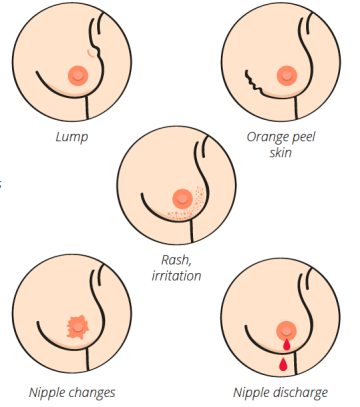Breasts cancer
Breasts, also known as boobs, are mainly responsible for the production of breast milk. However, we can't deny their aesthetic and seductive function. A breast tumor is formed from abnormal cancer cells that have lost their original function and gotten out of control. How can you prevent this?
Causes of disease
The unequivocal cause of breast cancer is not known. It is proven to affect women much more often than men. The occurrence of breast cancer cannot be completely prevented, but with timely diagnosis, it is possible to detect the tumor at an early stage and thus ensure a very high chance of a complete recovery.
Manifestations of breast cancer
How to recognize that something is happening and what to watch out for?
- Bulk
- Orange peel skin
- Rash, redness
- Nipple changes
- Discharge from the nipple

How can I prevent breast cancer?
- Do a self-examination.
- After the age of 45, go for a mammogram examination once every 2 years, which is covered by the insurance company. You can find a list of mamocenters at www.mamo.cz.
Frequently asked questions
Is a mammogram or ultrasound better?
In young women (before pregnancy or up to 40 years old), an ultrasound examination is usually performed. This is because the mammary gland has a different structure than in women after breastfeeding at an older age and after menopause, and the findings are more visible on ultrasound during this period. At an older age, a mammogram is performed for the same reason. If in doubt, both methods are combined.
Does a mammogram cause cancer?
Mammography uses ionizing radiation (as in an X-ray), which has few side effects. However, this is a very low dose similar to what we receive on international airplane flights. The benefits of mammography far outweigh the risks.
Does a mammogram detect every tumor?
On a mammogram, we primarily try to capture calcification, which is millimeter. If the mammogram findings seem suspicious to the doctors, they will send you for further examinations such as ultrasound or magnetic resonance imaging. There are areas that the mammogram does not "see", because the main part of the mammary gland is pressed, and if the finding were, for example, higher on the chest, it may not show up during the examination.
Are there some tumors that are not obvious on a mammogram but can be felt? A mammogram is particularly good at detecting calcification, which is often found in tumors, starting with a size of about 1 millimeter. You can feel the structure from about half a centimeter. It can be, for example, a cyst or a benign tumor (e.g. fibroadenoma), which can be seen on a mammogram, but may not be completely clear.
Can breast cancer occur during pregnancy?
Yes it can. Women should self-examine during pregnancy and while breastfeeding.
What is the effect of breastfeeding on the development of cancer? Is breastfeeding a protective factor for breast cancer?
Yes, the mammary gland "ripens" during pregnancy and breastfeeding, and there is a lower risk of developing cancer.
Is it possible to self-examine with breast implants?
Yes, women with implants should do self-exams regularly. Breast implants do not interfere with mammography or ultrasound.
Is there something wrong if my breasts hurt during my menstrual cycle? What can this mean?
If this symptom is regular during a certain part of the cycle, it is probably pain caused by fluctuations in the level of hormones. Hormones can cause the mammary gland to expand, which then presses on the surrounding nerve plexus. However, if the pain appeared suddenly or is accompanied by other symptoms, it is advisable to visit a gynecologist.

